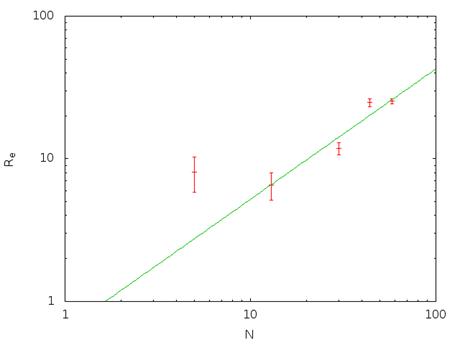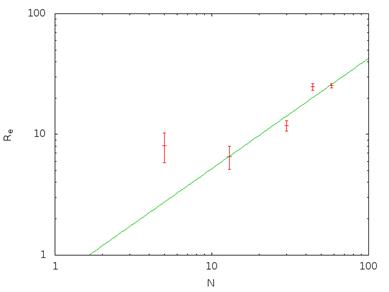Reports: DNI654235-DNI6: Molecular Modeling of Shape Transformations in Polystyrene Vesicles
Sharon Loverde, City University of New York (Staten Island)
Molecular Modeling of Shape Transformations in Polystyrene Vesicles
The overall goal of this proposal is to develop new coarse-grained models of polystyrene and polystyrene-based membranes to characterize shape transformations in polystyrene vesicles. To begin with, the PI and her laboratory have concentrated on the first portion of Objective 1.
As
was discussed, the PI and her laboratory have designed a coarse-grained model
for polystyrene based on all-atomistic simulations of PS. This model needs to be tested in hydrophilic,
theta, and hydrophobic solvent environments, to ensure the proper scaling
behavior.
To begin with, the PI and her laboratory performed additional all-atomistic simulations of PS using an all-atomistic potential is based on the CHARMM36 general force field. The simulations consisted of 7 different lengths of polystyrene in water as outlined in Table 1.
Table 1. Average radius of gyration Rg and end-to-end distance Re for multiple lengths of PS in water, including simulation box size and number of water of atoms.
|
monomers |
<Rg> [Å] |
dRg [Å] |
<Re> [Å] |
dRe [Å] |
Box Size [Å3] |
water atoms |
|
5 |
5.05 |
0.22 |
8.04 |
2.23 |
100x100x100 |
96447 |
|
10 |
100x100x100 |
96309 | ||||
|
13 |
6.61 |
0.16 |
6.56 |
1.42 |
100x100x100 |
96195 |
|
22 |
100x100x100 |
95940 | ||||
|
30 |
8.43 |
0.06 |
11.78 |
1.15 |
100x100x100 |
95703 |
|
44 |
10.34 |
0.12 |
24.77 |
1.57 |
100x100x100 |
95331 |
|
58 |
11.4 |
0.11 |
25.43 |
1.02 |
100x100x100 |
94896 |
The average radius of gyration and end-to-end distance of the polystyrene chain were calculated for the last 5 ns of a 50 ns simulation. Following, this data was used to obtain a power dependence of the end-to-end distance of the polymer Re versus number of monomers N in the polymer chain as shown in Figure 1.
Figure 1. The average end-to-end distance of the polystyrene chains for the last 5 ns of a 50 ns simulation. The fit Re (N) = 0.63N0.92 gives a much higher exponent than expected.
The fit Re = 0.63N0.92 gives a much higher exponent than expected. It is expected that PS would collapse to form a globular shape, for which 1/2 > ν >1/3. Thus, additional sampling of chain conformations are needed.
Following, the PI and her laboratory have computed the free energy surface as a function of radius of gyration using Metadynamics within the collective variables module of NAMD2. Several sets of parameters are chosen: fluctuation amplitude for polymer radius of gyration has two settings, of 0.5Å and 2.5Å, and energy hill weight has also two settings, of 0.01kcal/mol and 0.1 kcal/mol. At the minimum energy configuration, all PS chains exhibit a collapsed state as shown in Figure 2.
Figure 2. Snapshots from molecular dynamics simulations of multiple lengths of polystyrene in water at the minimum energy configuration a) 5, b) 13, c) 44 and d) 58 PS monomers in water In these simulation runs, h = 0.01 kcal/mol (a, b, and c) and 0.1 kcal/mol (d) and w = 0.5 Å. The polymer chain is displayed in a licorice representation. The head and tail hydrogens in the hydroxyl group are highlighted using a blue van der Waals representation. Water is indicated by transparent cyan background.
At the minimum energy configuration we calculate the average end-to-end distance as a function of polymer length N as shown in Figure 3. The fit Re = 4.69N00.32 (ν = ± 0.08674) gives an exponent close to 1/3, which is the power law we would expect for a polymer in a bad solvent environment.
Figure 3. The average end-to-end distance of the polystyrene at the minimum energy configuration as a function of polymer length N. The fit Re (N) = 4.69N0.32 gives an exponent consistent with a polymer in a bad solvent environment.
Presently, the same lengths of PS polymers are being simulated with the previously described coarse grained model. Initial analysis after 50 ns simulations indicates that the polymer model needs to be further refined. Bonds, angles, and dihedrals are being compared between all-atomistic and coarse-grained simulations. Following, short range parameters to describe the backbone-backbone, backbone-ring, and ring-ring type beads will be fitted such that the average radius of gyration and end-to-end distance will match all-atomistic results.
Impact.
This grant has allowed for the partial support of one postdoctoral fellow. Additionally, one graduate student has worked on this project. She has just advanced to the secondary level of her PhD thesis. The content of this proposal would serve as the subject for her PhD thesis. Additionally, receiving this grant has given confidence to my department in my ability to seek and acquire external research funding. It was viewed very favorably in my recent mid-tenure review.














